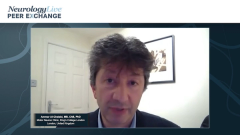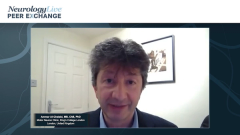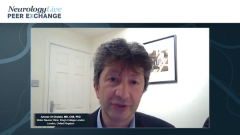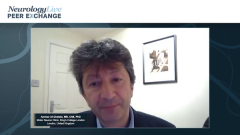
Approaches to Pharmacologic Management of ALS
Expert neurologists discuss clinical trial design and FDA approvals for current approaches to pharmacologic management of amyotrophic lateral sclerosis (ALS) and share personal experiences.
Episodes in this series

Richard S. Bedlack, MD, PhD, MS: Let’s delve into pharmacological management. We will talk about FDA-approved drugs as well as drugs in development. Ammar, riluzole, also known as Rilutek. What can you tell me about that 1?
Ammar Al-Chalabi, MB, ChB, PhD: It is an interesting drug. It was found serendipitously, so the mode of action was thought to be related to the glutamatergic hypothesis of ALS [amyotrophic lateral sclerosis]. That is the idea that, for most neurons, when 1 neuron talks to the next neuron, it usually inhibits it. You cannot over-inhibit a neuron because it goes to 0, but some neurons excite the next neuron in the chain with glutamate, for example. It is possible to overexcite a neuron more than 100%. If that happens, then the neuron that is being hyperexcited is prone to death: to apoptosis or some similar process. That is called excitotoxicity.
Riluzole was designed because it is known to interfere with that glutamatergic transmission and modulate it to reduce it. That is why it was tried. It was trialed in the early 1990s. By 1994, it had been through a sufficient phase 3 trial that there was evidence that it provided benefit. But since then, other drugs that have a similar mode of action have not shown the same result. This suggests that the mode of action of riluzole is something different. It does not mean it definitely is, but it does make it seem more likely that it is something different, which is frustrating because if it had been the same, we would have hopefully been able to make a riluzole-plus that was better than the existing riluzole. Because it is an unknown mechanism of action, essentially, we do not know what to do to make an improved version.
Richard S. Bedlack, MD, PhD, MS: Is it always a pill, Ammar, or does it come in different forms?
Ammar Al-Chalabi, MB, ChB, PhD: It is generally a 50-mg tablet, which is supposed to be prescribed twice a day. It is also available as a liquid, not just as tablets. If someone has a gastrostomy tube, then a liquid can be useful. In the United Kingdom, at least, the liquid can be difficult to obtain, so some people crush the tablet and add it to yogurt and put that down the tube. That is not how it is licensed to be used. Theoretically, the drug might stick to the plastic of the tube if it is not used in the correct way, but if there is no choice, then that is what people do.
Richard S. Bedlack, MD, PhD, MS: When people come to me the first time, a common thing I hear is, “I heard about riluzole, but I was told it gives me only 2 extra months and it messes up my liver.” Is that accurate?
Ammar Al-Chalabi, MB, ChB, PhD: I do not think that is accurate. Of course, there is a risk of the liver enzymes rising. It is known to do that in a portion of people. In my experience, I would say that probably about 10% of people will have that. In all the cases I have seen, stopping the drug or reducing the dose has reversed that change, and the liver enzymes have reverted to normal. In 1 case, in 27 years of prescribing it, I have seen the blood count drop. When we stopped the riluzole, it reversed. Those are known adverse effects, but they are unusual if the correct precautions and blood tests have been used.
Addressing the 2-month survival aspect, the original clinical trial showed about a 2-month improvement in survival at 12 months. Remember, the original clinical trial was an 18-month trial, so it could not provide data beyond that. The interesting thing about it, to me, is that the technique used to come to that conclusion, the 2-month survival, was a Cox proportional-hazards regression analysis, which is a special type of survival analysis.
One of the assumptions of that type of analysis is that the change in risk is constant: It does not change during the course of the disease. In fact, it was a 38% improvement in survival that they showed, which translates to about 2 to 3 months. That 2- to 3-month improvement in survival is a percentage survival at 12 months, and you should theoretically see that improvement continued throughout the disease as an average change. Of course, we have the problem that Jeremy suggested at the beginning, which is that we do not know if everybody is a responder to the same amount or if there are some people who are bigger responders and other people who are less so, and the average is 2 months. That is probably the case.
It is not just 2 months of survival. It is a 38% improvement across however long you would have lived. That is what the original trial says. That is different from 2 months, at 12 months, which is how people interpreted the original trial. Not all my colleagues would agree with that, but that is how I interpret that data.
Jeremy M. Shefner, MD, PhD: I would say, even more strongly, that there are a host of studies that compared survival in different countries prior to the approval of riluzole and then again afterward. In the majority of those, there was some variability in the results, but the majority of those studies suggested an improvement in the life span of closer to a year. Those are not as well controlled, but they also may reflect the real world better to some extent.
Richard S. Bedlack, MD, PhD, MS: Thank you.
Ammar Al-Chalabi, MB, ChB, PhD: If you were going to live 10 years, then a 38% improvement is 3 or 4 years.
Jeremy M. Shefner, MD, PhD: That’s a lot.
Ammar Al-Chalabi, MB, ChB, PhD: It is a lot, yeah.
Richard S. Bedlack, MD, PhD, MS: That is a great way to look at it. Jeremy, edaravone, also known at Radicava in the United States, is another FDA-approved drug for people with ALS. What can you tell us about that?
Jeremy M. Shefner, MD, PhD: Ammar suggested that riluzole was a serendipitous discovery. I believe that edaravone was as well. Edaravone is a drug that was developed in Japan many years ago to combat acute stroke. It is an intravenous [IV] drug and was given for 14 days as soon as the patient was admitted to the hospital with stroke. The data in Japan suggested that stroke severity was somewhat ameliorated. I do not know what the leap was to go from stroke to ALS, but there was a small academic study that looked at edaravone in ALS.
The dose regimen was not conceived of in any particular thoughtful way. They picked the dose used for stroke, the 14 days of IV treatment, and they realized that it was probably impractical to give this to patients with ALS every day forever. They took a couple of weeks off, and they then started giving it 10 of every 28 days. It did not show a statistically significant benefit in the first trial, but it showed a trend toward some slowing of progression. The manufacturer of the drug then became more interested in it and supported a larger study, which was approximately 160 or so patients, of which 80 were given placebo and 80 were treated. It again showed some trends toward slower progression, but it was not statistically significant when the entire cohort was looked at. Subsequent post hoc analysis suggested that the earlier the patients were in their diagnosis and the more diffuse their disease was when they started treatment, the better they did. The actual amount of change in the ALS Functional Rating Scale [FRS], which was the primary outcome measure, was greater in these patients who were early onset and more rapidly disseminated early on. It was not statistically significant, but it appeared to be numerically different. If that treatment were reproduced in a bigger study, it would potentially be clinically important.
A further study was conducted, and it was pretty small. It was about 136 patients, equally divided between treated and untreated patients, looking specifically for early onset patients who had disseminated ALS who also were progressing, at least at some criterion rates. Slow progressors were not allowed, so they took this subset that they saw the biggest change in and then did their study in those patients and found a statistically significant and clinically meaningful change in that, at the end of 6 months, the patients treated with the drug were about 33% slower in their rate of progression measured by the ALS FRS than the placebo patients. This is the study that led to FDA approval.
In the United States, there was not complete unanimity among ALS experts as to whether this was sufficient evidence to support approval. My view is that it was. It was a well-designed trial, and the effect was quite significant. Other secondary outcome measures went along in the same direction. The question was this: If the study was performed on only these patients with early onset—with rapidly progressive, disseminated ALS—is that the only group of patients that the drug works on?
That kind of reasoning informed third-party payers’ ability or willingness to pay for a drug for ALS for a long time. My own opinion is that the investigators did a clinical trial trick that was wholly appropriate. They looked at patients that they thought, in a small, short trial, would be more likely to have a bigger effect than others, and that is whom they attended to. There was nothing, at least in my mind, about those patients that was etiologically different from the other patients. The previous study showed trend in every kind of patient with ALS toward the same beneficial effect, so my view is that the drug works.
I encourage it for everybody. It has an attractive adverse-effect profile. It is difficult only because it requires IV access and either home- or infusion center–based therapy 10 of every 28 days.
Richard S. Bedlack, MD, PhD, MS: Jinsy, you have had experience with both these drugs. Tell me about what your experience with riluzole and Radicava [edaravone] are like.
Jinsy A. Andrews, MD, MSc: Since edaravone was approved in the United States, I proactively talk about the approved therapies at the start of the diagnosis as treatment option. We will often initiate riluzole first after a discussion of the risks and benefits, mainly because it is available in generic form, and it is available at all the pharmacies. It is easy to prescribe, and it is an oral tablet, so it is easy to take. In the United States, we have the liquid form, but it has some challenges to access because of cost. I believe there is a recently approved oral film of riluzole as well, but that is not easy to access.
The tablet form is usually the formulation that we prescribe first. For edaravone, most patients are willing to try it and give it a shot to see how they feel. The first question I always get is, “Am I going to feel different?” This is difficult to answer because, based on the clinical trial data, we are intending it to slow down disease progression. I often have to make an analogy almost to their diabetic medications or their blood pressure medicines. They are not going to feel anything. It has an effect, but it will not be easy to tell.
Most patients take it in our clinic at Columbia University Irving Medical Center, but that can be variable from clinic to clinic in the United States because of the payer situation and the because of physician attitude. Even people living with ALS might read the data and say, “What does that 2 to 3 months mean for me? Is that the last 2 to 3 months? If I have lost a lot of function, then I do not want to be around for that 2 to 3 months, so maybe I will not even start it.” It is difficult. In our clinic, we have 60% to 80% of patients who say, “Yes, go ahead right away.” From clinic to clinic, it can vary. It can be as low as 30% or 25% of the clinic population in the United States. That is driven a lot by physician attitude, about them thinking it is a modest medication.
With edaravone, it is a lot newer. It has just a couple of years of experience for us. We present the data and present the risks and benefits, but the route of administration poses a challenge in our clinic. We are not able to provide the infusion at our center, so we often have to ask for prior authorization for the medication and for home nursing or an outpatient infusion center. It is a bit more complicated to access the medication, but I agree with Jeremy: For the people who have taken it, the medication itself does not pose any challenges. It is more the access to the medicine and the line management that are challenging.
For the peripheral IV access, often we use PICC [peripherally inserted central catheter] lines, or we use a port catheter. For certain people and for several of our patients, we have had complications where either the line has a malfunction or there might be skin-integrity issues for PICC lines or infections. I have sometimes had a port-catheter-infusion site that does not heal properly, which I thought may be an ALS-specific thing because I have not had that happen in other disease populations. It is a lot of work. If anyone were to say no to it, it would be the people who might be just a little too healthy and say, “I do not want to have to do all that quite yet.” I have people who are working who do not want to maintain lines while they are doing their work, which may require physical activity. Oddly enough, living in New York, we have some people who want to go to warmer climates in the winter and swim. It is hard to manage a peripheral IV access and enjoy the beach and pool. Those are some of the challenges.
Richard S. Bedlack, MD, PhD, MS: Thank you for watching this NeurologyLive® Peer Exchange. If you enjoyed the content, please subscribe to our e-newsletters to receive upcoming Peer Exchanges and other great content right in your in-box.
Transcript Edited for Clarity
Newsletter
Keep your finger on the pulse of neurology—subscribe to NeurologyLive for expert interviews, new data, and breakthrough treatment updates.




























